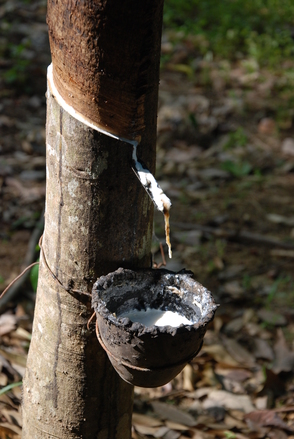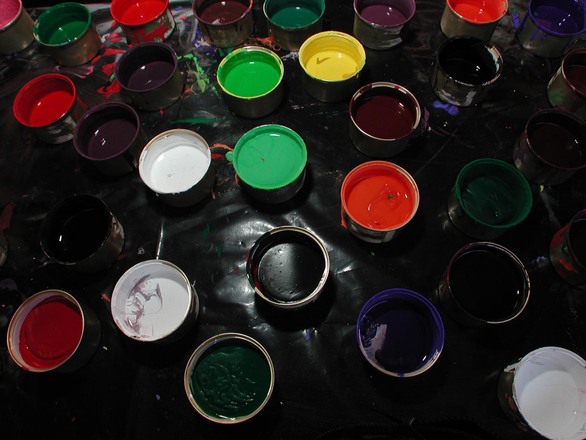by Ignacio
Martín-Fabiani*
Department of Physics,
University of Surrey, GU2 7 XH Guildford, United Kingdom.
*I am part of the Soft
Matter Group, where we are particularly interested in all sorts of applications
of soft materials. The project I am working on aims to develop new paints and
coatings which are more environmentally friendly than the ones in the market.
So I could say I am living proof that you can get a salary for watching paint
dry!
Have you ever wondered
what is paint made of? And why a milky liquid like a varnish becomes
transparent when it dries? Well, I will try to provide answers to these
questions in this post. The main component of any paint or varnish is a
dispersion of small particles in a liquid. How small? Really small. And how small is that?
 |
|
The basic component of paint is a
dispersion of very small plastic particles in water: A latex. Image by tookapic, via
Pixabay. CCO 1.0 Public Domain.
|
Just take one of your
hairs and imagine that it is cut into a thousand pieces. Each of those pieces
would have the size of the particles floating in your paint. That means you
cannot see this particles with you bare eye, you need a microscope to visualize
them. And it turns out they are polymer particles! So under the microscope you
would see a world of plastic spaghetti within them. What about the liquid
surrounding the particles? That depends on the manufacturer – if it is a
water-based paint, it will be more enviromentally friendly. Why? Because when
it dries, only water vapour is released to the atmosphere. However, a
solvent-based paint contains organic solvents such as benzene or toluene. You
will recognize this type of paint by the strong odor of something that has been
fresh painted. These solvents are released when the paint dries and are
hazardous to both the environment and human health. This is why there is a
trend to reduce the amount of solvent-based paints in the market. So for this
article we will stick to water-based paints, that is: A dispersion of small
polymer particles in water. There is another name for that combination, which
might sound familiar to you: latex.
 |
|
Latex
is natural, extracted from the rubber tree. However, most latexes used in
paints are synthetic. Image by Konstantino Dafalias, via Freeimages.com . Freeimages license.
|
What comes to mind when you think of
latex? Right, gloves and condoms. In fact, these things are made by dipping moulds
with the desired shape in latex dispersions and letting it dry. But of course
paints are not only made of latex – they have plenty of other additives in
their formulation. There are wetting agents, which allow paints to spread more
easility onto surfaces. Without them a paint would not spread homogeneously, forming
droplets instead of a continous layer - like rain does on a window. Also
pigments are necessary when a coloured paint is needed. Depending on the color
different pigments can be used, mainly metal oxides: Titanium oxide (white),
iron oxide (red, orange, yellow, brown) and chromium oxide (green). Black
colour is obtained by adding carbon particles. In fact, anytime you leave your
food in the oven for longer than necessary, those black spots you see are just
carbon. Because you burned away all the other elements! That is called the
carbon black colour. And why do we see paints white, red or black? Why the
different colours? Well, here is a bit of Physics. Sunlight is composed of
lights of all the different colours: red, orange, yellow, green, blue and
violet. The combination of all these together is called white light. When an
object is iluminated, it absorbes some or all of the sunlight colours and
reflects others. The reflected colours are the ones that we perceive. So for
example a tomato (a ripened one!) absorbs all colours but red, and that is why
it looks red, because it is reflecting that particular colour into our eyes. For
example, coming back to pigments, white paint looks white because the titania
dioxide inside it is reflecting all the light components, thus generating white
light.
 |
|
Different paint colours are obtained by
adding pigments to latex: They reflect the colour that we see with our eyes.
Image by Mark Tullos, via FreeImages.com. Freeimages license.
|
But what about clear varnishes? They look
milky when they are in the can, and even after application. So why do they become
transparent upon drying? In fact, its two main components (water and tiny
polymer particles) are both transparent. But when you put them together they
look milky! To explain this, we have to introduce a new concept: the refractive
index of a material. Light travels through air, water or other mediums at different
velocities, depending on their optical properties. Its refractive index is
defined as the ratio of the velocity of light in the air (more precisely, in
vacuum, that is, in space) to that in the material. When light rays cross the
boundary between two media with different refractive index, in addition to a
change in velocity they also experience a direction change. This effect is
known as refraction, and in the process some light can be reflected. This reflected light does not have a
preferential color because the arrangement of particles is completely random
and that is why it looks white to us. When the varnish dries, water evaporates
and polymer particles pack together. We still have two refractive indexes: one
for the polymer particles and another one for the air that is in the small gaps
between them. But polymer particles in paints and varnishes have their glass
transition temperature well below room temperature. That means that they can deform
and entangle their chains with the adjacent polymer particles, thus eliminating
air voids and creating a continous polymer layer. Therefore, at the end of the
process we end up with only one refractive index (that of the polymer particles)
and a trasparent layer of varnish on our surface!
As you can see, behind
simple objects such as paints and varnishes there is a lot of science involved:
chemistry, physics and materials science. So next time you are painting
something, and it takes ages to dry, try recalling the process that is taking
place. That will make the wait less painful. I guess.
References
Keddie, J. L. And Routh, A. F. 2010. Fundamentals
of Latex Film formation. Springer-Verlag Berlin Heidelberg.

No hay comentarios:
Publicar un comentario